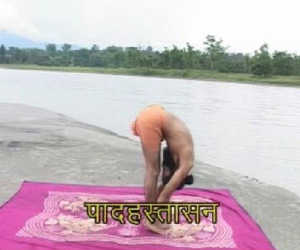Padahastasana | Standing Forward Bend
Pada means ‘foot’ and hasta means hands in Sanskrit. Pada hasta means from hand to foot. This asana is also included in surya namaskar sequence that is at third and tenth pose. It is good for muscles and skeletal system.
Process
1. Stand in Tadasana, exhale and bend downward from the waist.
2. Keep your legs straight and bring your finger tips or if possible your palms gently on floor, in front of your legs, or put the hands beside your legs.
3. Place your face on legs.
4. Remain in this position for few seconds.
5. Now inhale slowly and return back to start position.
6. Repeat this posture after relaxing for a while.
Duration
Don’t do it for more than from five to six times initially. Later on it can be extended up to a minute.
Benefits
- Tones abdominal organs.
- Bloating of abdomen,constipation,indigestion,other gastric problems really get alleviated.
- Spine become straight, flexible and resilient.
- Reduces fat around abdomen.
- Helps to gain height.
Precautions
- Persons having back problems should avoid it.
- Consult the doctor before starting doing this asana who are suffering from ailments.
